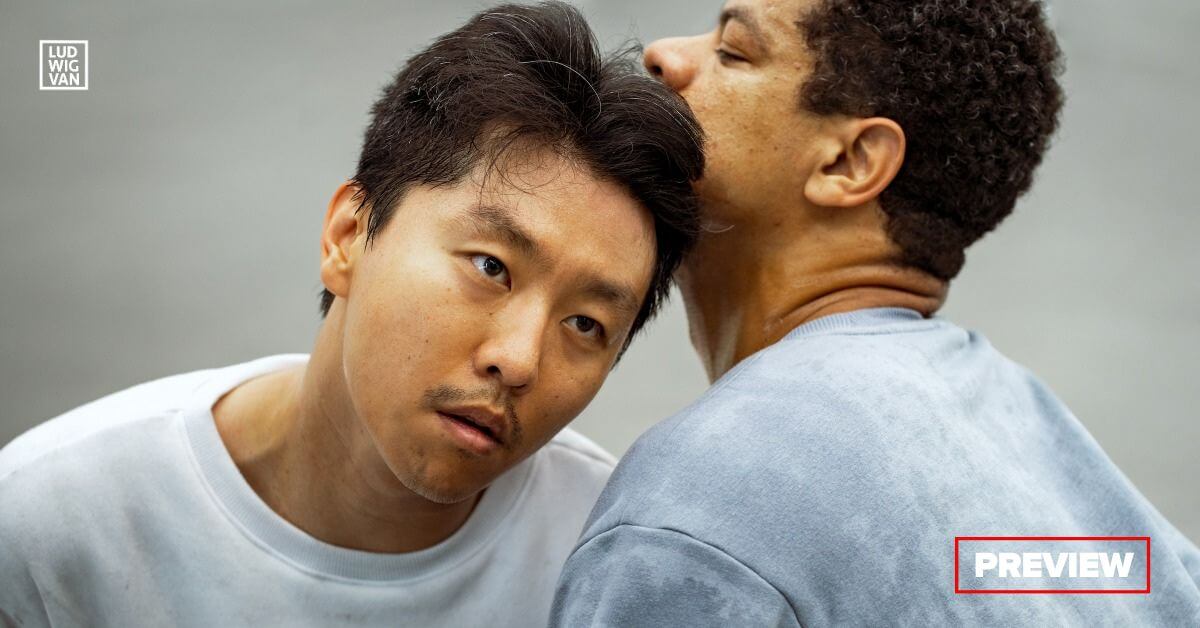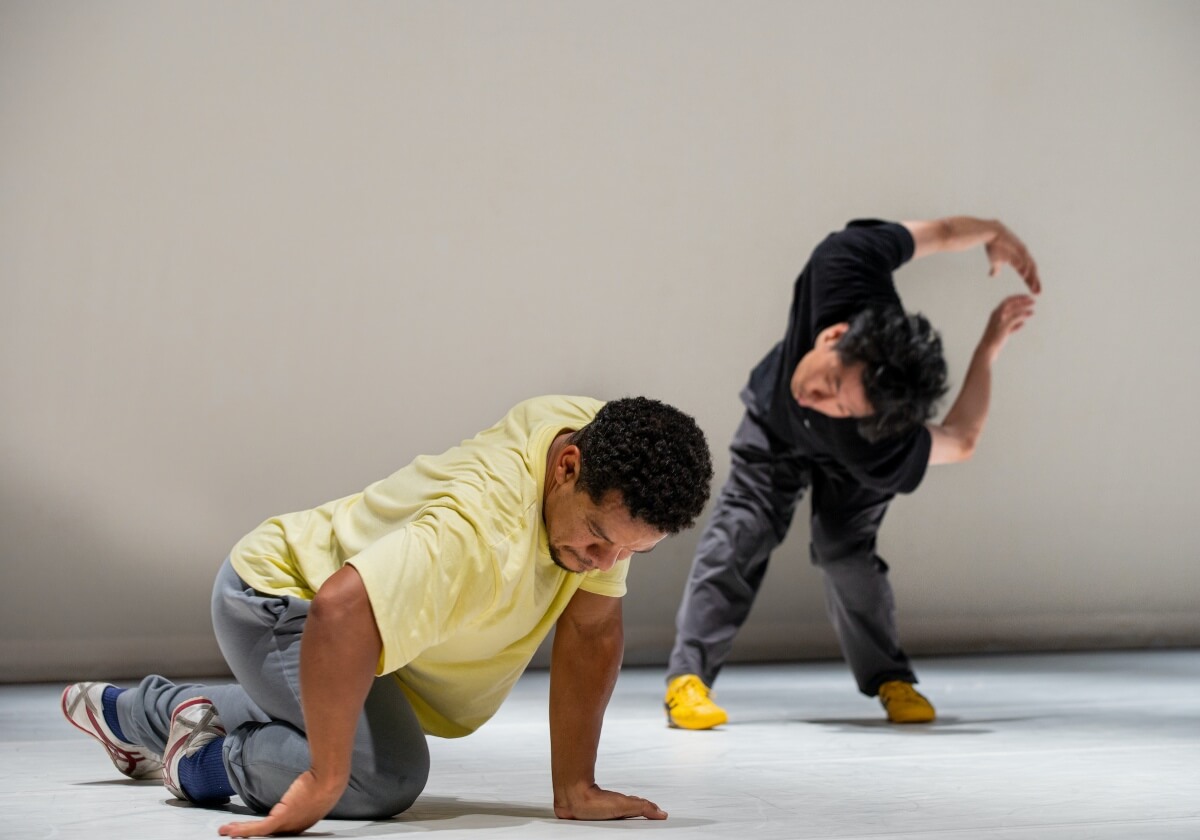
DanceWorks and Harbourfront Centre present Deciphers by Naishi Wang and Jean Abreu, with performances at Toronto’s Harbourfront Centre February 8 to 10. It’ll be the Ontario premiere for the work, presented as part of the Torque contemporary dance series.
The creative team backing up the dancers includes lighting design by Lucie Bazzo, visual design by Ivy Wang, sound design by Olesia Onykllenko, and dramaturgical advice from Guy Cools and outside eye Ginelle Chagnon.
The result is a kind of hybrid of dance and theatre that blends movement and rhythmic sequences with multilingual spoken word. In a statement Nathalie Bonjour, Director, Performing Arts at Harbourfront Centre, calls it an “extraordinary use of the body as a tool of linguistic expression”.
We spoke to dancer/choreographers Naishi Wang and Jean Abreu about how this unique work came to fruition.
Naishi Wang and Jean Abreu
Naishi Wang was born in Changchun, China, and grew up learning martial arts as well as Chinese classical and folk dance at Jilin College of Art. He emigrated to Toronto in 2004, and studied dance at the Dance Arts Institute (formerly School of Toronto Dance Theatre).
Jean Abreu is a native of Brazil, and his early life was steeped in the rhythms and dance of that country, a language that informs his work today. Jean moved to London, UK in 1996 in order to study at Trinity Laban Conservatoire for Music and Dance. He is Artistic Director of Jean Abreu Dance, the company he founded in 2009.
Deciphers also adds spoken word to the movement and music, inspired by Canadian poet Mark Strand and Brazilian poet Fernando Sabino. The elements come together to examine the ways that immigrants negotiate the complex issues of communicating across not only a language, but a cultural gap.
While the materials indicate that the work has been in progress since 2020, it turns out the connection between the two artists goes back even farther.

The Interview
“Deciphers began with Naishi and I — I like to joke — with flirting each other online,” laughs Jean.
The two had discovered each other’s works via the relatively small world of global contemporary dance, and admired it.
“We started to naturally get drawn to each other’s work.” Officially, he says it was dramaturge Guy Cools who made the official introduction in about 2019. “It was clear that we wanted to collborate.”
Naishi had been offered a residency in 2020 where they planned on working together, but the meeting was axed because of the onset of the pandemic. The two continued to communicate and collaborate online through the lockdown period on the work. Jean was finally able to come to Canada, specifically Ottawa in the cold winter, in 2021 to meet in person. Through a five-week period, they were able to hammer out the ins and outs of the production.
That initial project underwent further development and performance at a residency in Nottingham, and another at Dance City at Newcastle Upon Tyne in the UK. Throughout, the project was supported by organizations in Canada and the UK. Deciphers had its Canadian premiere at the PuSh International Performing Arts Festival in Vancouver.
From the recent Vancouver performance of Deciphers:
“We are so excited at Harbourfront,” Naishi says.
“This is an international collaboration,” adds Jean.
Every dancer brings their background to their current work, and as contemporary artists, the dichotomy of Brazilian vs. Chinese traditions is something that wasn’t initially a priority to express. “I think in the earlier stage, we didn’t think about this too much,” says Naishi.
The idea of how the converging cultures and immigrant realities are expressed came out of working through the choreography.
“We contacted William Lau,” he notes. Lau is a noted expert in Chinese opera. “This idea of forming the new culture, to preserve the new culture, to meet in the body,” Naishi explains the concept behind it. In terms of background elements, it juxtaposes the breathing, the aesthetic language of Chinese dance with the passion and physicality of Brazilian. But, it’s not about quoting from folklore. “Inside of specific dance types and form, we can embody this atmosphere, this feeling, this essence of each culture’s dance.”
The choreography evokes the feelings of culture shock, of how immigrants absorb and react to the new environment and all its challenges. “We are attracted to this transformation, and what did it take,” Jean says. “That dance of unpacking, and changing and transforming […] it was more a sphere of interest.”
He talks about the “bodily immigrant experience, is how do we let thing appear.?” An immigrant is constantly moving from one place and arriving at another place, but is actually in neither, as he explains it.
“We ask, where is there?”
Along with the movement, there are also moments of silence. “We really wanted to allow in Deciphers, the space to be there.”
Spoken Word
Naishi likens writing poetry to thinking about dance. “We try to lay out the poetry as an empty space,” he explains. It’s not always directly addressed in the movement. The spoken word elements act as a “translation of our bodily experience,” he adds. In using Mark Strange’s poem “Keeping Things Whole”, the work was translated from English to Chinese, “then from Chinese to the body.”
Jean was attracted to the work of Brazilian poet Fernando Sabino, and a particular piece. The quote that drew him, translated from Portuguese, goes something like this:
“After all we’re left with three things: a certainty that we’re always just beginning, a guarantee that we must keep going but also that we will most likely be interrupted before getting to the end. Therefore we must turn interruption in a new path, downfall into a dance, fear into a ladder, our dreams into bridges and our needs into an encounter.”
Jean was attracted to the inherent message. “The sense of having to constantly reinvent.” Language and voice, as he notes, are both extensions of the body. “The element for us is like another movement,” he says.
The set is minimalist, keeping the focus on the movement and sound. “We use music, but we also use silence,” Naishi says. “I think the core idea of Deciphers is to translate the immigrant experience, but that’s not all.”
As he remarks, immigrant experiences are varied, and can’t all be funnelled into one paradigm. The two dancers express those variations.
“We use this idea — understanding mixed with misunderstanding — communication is imperfect,” he says, “a different perspective, but a similar journey.” Their movements aren’t necessarily in sync. “We are in the same feeling together, to highlight the differences. We kind of wanted to focus on the individual experience.”
That, as he points out, is one of the great advantages to immigrating to Canada — the sheer diversity of immigrants from so many different countries, and even regions within those countries.
The combination of duality and commonality makes for a vibrant dance experience. “I think that’s the specialness of Deciphers,” says Jean.
For audience members who don’t have firsthand experience of immigration, the performance speaks to universal elements of communication/miscommunication, and co-existence in a crowded world.
- Wang and Abreu will answer questions at a post-show Q&A on February 9. More information and tickets for the Toronto performances at Harbourfront Centre [HERE].
After Toronto, Deciphers will travel to Montreal to be performed at MAI (Montréal, Arts Interculturels) from February 14–17, and then in Ottawa at the National Arts Centre from February 22–23.
Are you looking to promote an event? Have a news tip? Need to know the best events happening this weekend? Send us a note.
#LUDWIGVAN
Get the daily arts news straight to your inbox.
Sign up for the Ludwig Van Toronto e-Blast! — local classical music and opera news straight to your inbox HERE.
- INTERVIEW | Composer Ari Kinarthy And Director Jeff Lee Petry Talk About Ari’s Theme, Premiering At Hot Docs - April 26, 2024
- PREVIEW | Creators & Performers Natalya Gennadi And Kristine Dandavino Talk About Grandma’s Shawl - April 26, 2024
- PREVIEW | Artistic Director Emily Cheung Dives Into Little Pear Garden Dance Company’s History & 30th Anniversary Peformance - April 26, 2024



